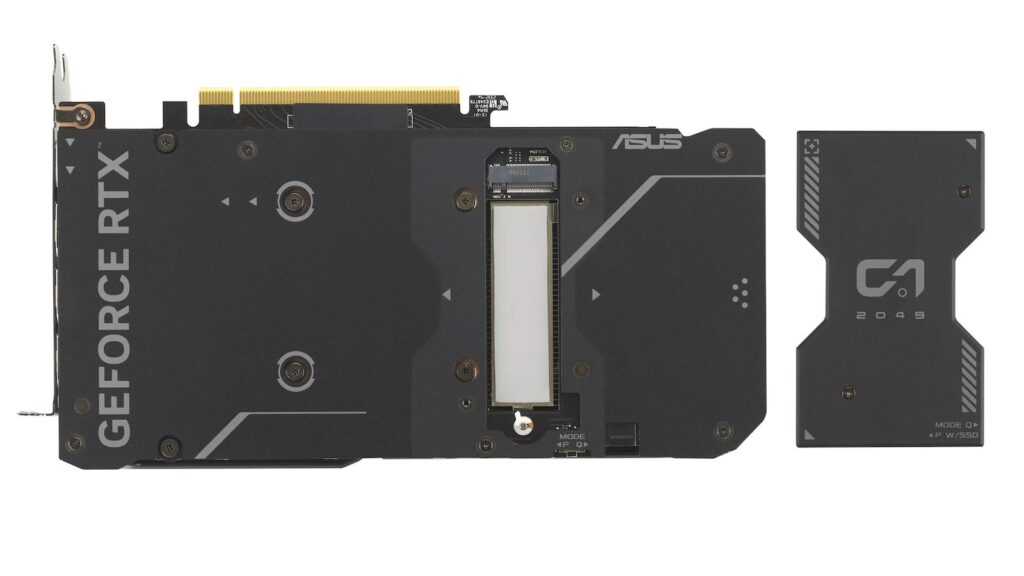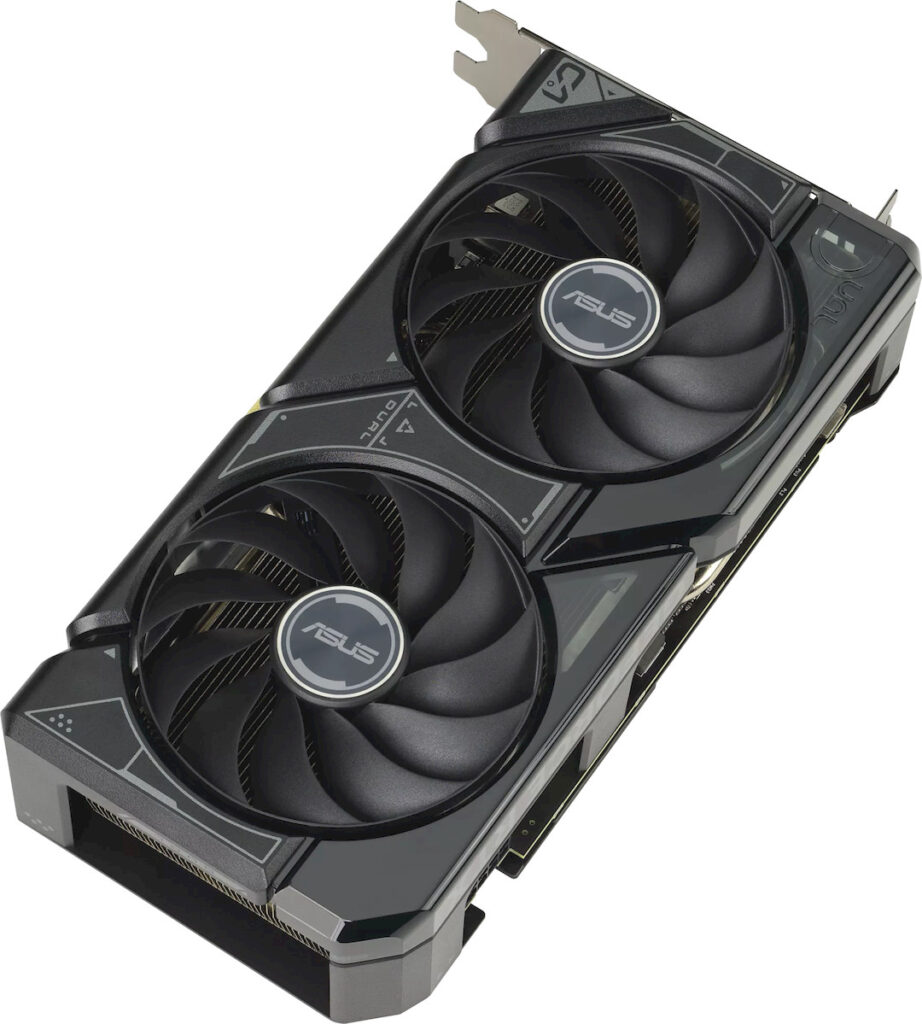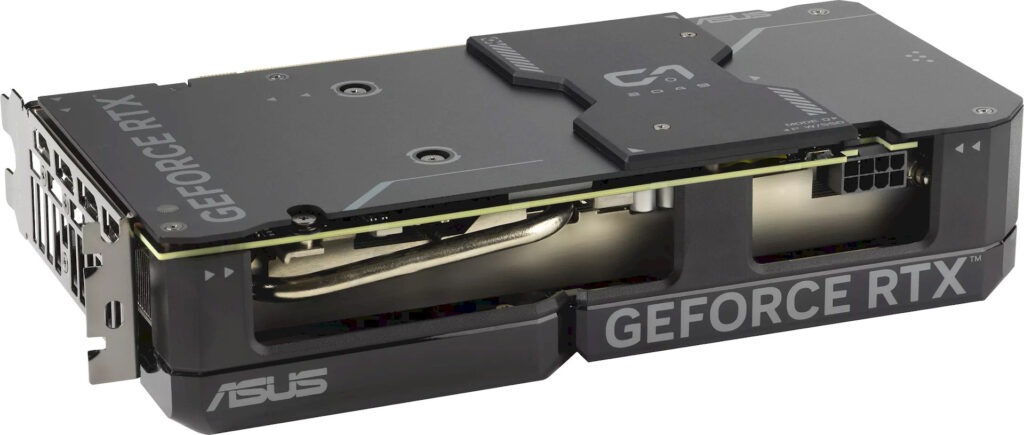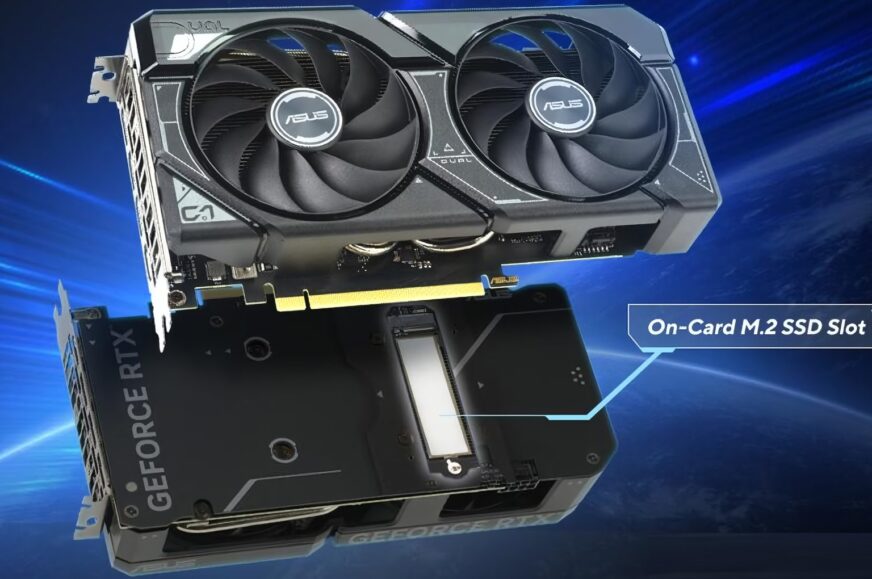Asus graphics card with an M.2 slot for SSDs is really launching on the market
Some GPUs in current gaming graphics cards use just eight PCIe lanes instead of the whole ×16 interface. This includes cards like the Radeon RX 7600 and also the GeForce RTX 4060 and 4060 Ti. Asus recently came up with an idea to make use of the extra lanes that would go to waste such a GPU, and made a graphics card that gets some utility out of of the excess lanes, using them to connect an SSD and provide an extra M.2 slot.
We already had information about this idea some time ago, when Asus showed the card on a video, back when it was still apparently in the prototype stage. This concept is finally coming to market (the PCB has been improved since the prototype, the signal path to the M.2 slot has been shortened, for example) and this unique design has been launched in the form of the Asus Dual GeForce RTX 4060 Ti SSD 8GB GDDR6 graphics card. There is also its sibling model with the OC Edition moniker, which has a slightly increased GPU clock speed.
This card is based on the design (or rather, the cooler) of the existing GeForce RTX 4060 Ti Dual graphics card with two axial fans and a 2.5-slot cooler, while the power supply is handled by a classic universal eight-pin connector. The cooling capability of this design probably shouldn’t be altered too much.
Compared to the standard model, however, there is the distinguishing feature of the M.2 slot obviously being present, which is connected to the other eight lanes that the GeForce RTX 4060 Ti card does not normally use (the slot consumes four of these extra eight lines). The slot is located in the PCB of the card, but not directly on the board. There is actually a cutout made in the printed circuit board in the footprint of the installed SSD, which means the SSD is mostly located in free space. This should, on the one hand, limit heat conduction from the hot GPU’s board to the SSD module – the graphics card PCB does get quite hot from the GPU and its VRM.

At the same time, this allows the SSD to have a contact (via a thermal pad) with the graphics card’s cooler’s heatsink in this cutout, which means the SSD’s heat output can dissipate into the GPU cooler through the prepared thermal pad. From the other side of the card, a cover can be installed on the SSD, which you can attach to the backplate of the card.
According to Asus, it is possible to achieve up to 40% better temperatures by installing the SSD into a graphics card compared to an installation in a motherboard slot, but this may be based on comparisons with motherboard slots with poor cooling conditions (either lacking a heatsink or airflow, or for M.2 slots placed underneath the graphics card slot where heat from the GPU is trasfered to the SSD module).

Intel platform only has support on boards with Z chipsets, AMD works almost always
On boards where there are no available M.2 slots, this graphic can replace another adapter for M.2 SSDs you would otherwise have to install into another PCI Express slot (which is something you can’t do on Mini-ITX boards). The SSD is connected directly to the lanes from the CPU, there is no active switch on the card. The downside is that the platform needs to support PCIe link bifurcation to ×8/×8 or ×8/×4/×4 lanes (this sometimes needs to be manually enabled in UEFI settings of motherboards).
According to the list of supported boards, this is support is widely present even on cheaper boards with AMD A620, A520, B650, B550 and B450 chipsets (outside of X470/X570/X670 where it’s obviously present too). But you have to be careful with the the Intel platform, because there you are limited to boards with Z690/Z790 chipsets and prior Z-chipsets (the less common H670/H770, Q670, W680, W790 work too). However, cheaper Intel chipsets do not support bifurcation, so this card won’t be useful on B660/B760 or H610 (and predecessor) motherboards.
PCIe 5.0 SSD for boards which don’t support it
However, this disadvantage put asside, there is also an advantage. Asus directly confirms that if you install the card into a PCIe 5.0 ×16 slot, then the M.2 slot on this graphics card also supports PCIe 5.0 ×4 speeds. This is despite the fact that the GeForce RTX 4060 Ti graphics itself only uses PCI Express 4.0 (apparently this doesn’t lock the rest of PCIe lines out for using PCIe 5.0 for the SSD). This may even open up the possibility of using PCIe 5.0 SSDs on some boards (of the LGA 1700 Intel platform) that otherwise don’t support it at all because they don’t have PCIe 5.0 brought out to any of their M.2 slots. The card adds such a slot for them.
The M.2 slot can theoretically accommodate more than just an SSD, as it has full PCI Express functionality. Tony Yu from Asus even demonstrated connecting an external GeForce RTX 4090 graphics to a system via an adapter installed in the M.2 slot and a cable. This isn’t exactly a realistic use case, but there are other adapters and bringing out four lanes to the riser can be useful, for example on a Mini-ITX board.

On the other hand, there is one thing to watch out for. Sometimes the motherboard itself supports “diverting” part of the PCIe ×16 lanes to an M.2 slot present somewhere on the board (which means the GPU is left with only eight lanes, naturally). This is what Intel uses to implement the PCIe 5.0 ×4 M.2 slot on Z690 and Z790 boards for Alder Lake and Raptor Lake processors, because they don’t have dedicated PCIe 5.0 lanes for SSDs unlike AMD processors, just for GPUs (ironically, this is exactly the opposite of what would be useful today, because you can use PCIe 5.0 for SSDs today, while you can’t for GPUs).
On a board like this, this graphics card with an M.2 slot is useless because it takes lanes that would already be used by that PCIe 5.0 slot on the board, so you aren’t getting anything new from the graphics card’s slot. You add one slot but lose one slot on the board. The Asus card only makes sense where the board itself isn’t capable of re-routing the excess eight lanes from the ×16 slot.
Specifications of this graphics card are otherwise standard and match the regular Dual model – it has 4352 shaders, 2535 MHz boost clock (in OC mode), or 30 MHz higher than that in the case of the OC Edition. It runs 8GB of GDDR6 memory on a 128-bit bus with an effective speed of 18.0 GHz (giving a bandwidth of 288 GB/s). The card provides three DisplayPort 1.4a and one HDMI 2.1a video outputs and is 22.72cm long.
However, Asus hasn’t yet disclosed when it will be available for purchase, so actual availability could be days or weeks away. We also don’t yet know how much the card will cost, i.e. how much of a premium will that extra M.2 slot will be compared to the regular Asus RTX 4060 Ti “Dual” card.
English translation and edit by Jozef Dudáš
⠀








